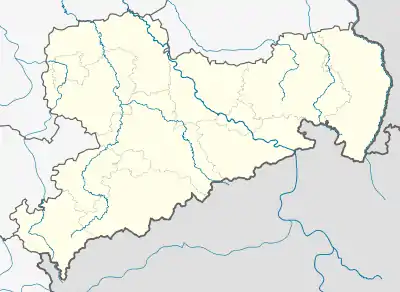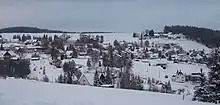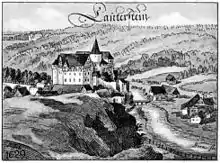Niederlauterstein
Niederlauterstein is a village in Saxony which has been incorporated into the town of Marienberg in the district Erzgebirgskreis since 1996.
Niederlauterstein | |
|---|---|
Location of Niederlauterstein | |
 Niederlauterstein  Niederlauterstein | |
| Coordinates: 50°40′13″N 13°9′3″E | |
| Country | Germany |
| State | Saxony |
| District | Erzgebirgskreis |
| Town | Marienberg |
| Area | |
| • Total | 3.052 km2 (1.178 sq mi) |
| Elevation | 556 m (1,824 ft) |
| Population (2021)[1] | |
| • Total | 626 |
| • Density | 210/km2 (530/sq mi) |
| Time zone | UTC+01:00 (CET) |
| • Summer (DST) | UTC+02:00 (CEST) |
| Postal codes | 09496 |
| Dialling codes | 03735 |
Geography

Niederlauterstein is a dispersed settlement (Streusiedlung), situated about 3.5 km (2.2 mi) north-east of Marienberg in the Ore Mountains. It extends from the left bank of Schwarze Pockau river for about 1.5 km (0.93 mi) westward on a steep slope. The ruined Lauterstein Castle which formed the origin of the settlement is situated on a rock spur above the river, at the eastern end of the village.
A former miners' settlement dating back to the 12th century, the abandoned village Schwedengraben, is located about 1 km (0.62 mi) southwest of Niederlauterstein.[2] To the east, Landesstraße 224 between Pockau und Kniebreche runs along the valley of Schwarze Pockau. Kreisstraße 8131 connects the western end of the village with Rittersberg and Kniebreche and with Lauta via Lauterbach.
History

The history of Niederlauterstein is closely connected with that of Lauterstein Castle, built in the second half of the 12th century[3] and first mentioned in 1304,[4] which was built to protect a medieval trade road between Leipzig and Prague across the Ore mountains. When castle and lordship were divided in 1497[5] into Nyder Sloß Lauttersteynn ("Lower castle Lauterstein") and zum Lawttersteyn,[6] a dividing wall was erected across the castle courtyard.
Since 1539, after the Protestant Reformation Niederlauterstein has belonged to the parish of Lauterbach. In 1559, Prince-elector Augustus installed the administration of the Saxon Amt Lauterstein in the castle.[7] The castle burned down in 1639 during the Thirty Years' War.[8]
Beginning in 1698, the sale of the Vorwerke Neudeck-Schäferei, Schlossmühle and Schweizer Vorwerk was prepared. Carl Gottlieb Leubnitz, Georg Heinrich Dürrfeldt and Curth Heinrich Einsiedel, commission agents of the prince-elector, were instructed to negotiate the contract which was completed on 26 September 1701 and which was confirmed on 23 December 1701 by Augustus the Strong in Warsaw. The farming estates together with their tracts of land were sold to 31 buyers, among them subjects of the Amt and other applicants. Since the estates had been property of the castle's share since 1497, the new village arising from them was named Nieder Lauterstein in 1701.[9]
A school was established in 1835 and a second one in 1884. Both were replaced by a new building in 1916 which is now used as a club house by the local history society.[10][11] After Schlossmühle mill on the right bank of Schwarze Pockau burned down in 1860, a flax spinnery was built in its grounds in 1865. It burned down in 1888 and was replaced by a paper mill for the production of paperboard in 1893. It closed in 1965, only the former proprietor's villa has been preserved.[12] The former manorial district of Schlossmühle was incorporated into Niederlauterstein in 1921.[13]
On 1. Januar 1996 Niederlauterstein was incorporated into Marienberg.[14]
Inhabitants
|
|
|
|
Bibliography
- Schumann, August (1820). "Niederlauterstein". Vollständiges Staats-, Post- und Zeitungslexikon von Sachsen (in German). Vol. 7. Zwickau. p. 272.
- Landratsamt Mittlerer Erzgebirgskreis, Hrsg.: Zur Geschichte der Städte und Gemeinden im Mittleren Erzgebirgskreis, Eine Zeittafel (Teile 1–3)
- Carl W. Hering (1828). Geschichte des sächsischen Hochlandes: mit besonderer Beziehung auf das Amt Lauterstein und angrenzende Städte, Schlösser und Rittergüter. Vol. 1. Leipzig: Johann Ambrosius Barth.
References
- "Zahlen und Fakten". Bergstadt Marienberg. Retrieved 24 September 2021.
- Volkmar Geupel (1984). "Sondierungen in der Wüstung Schwedengraben bei Niederlauterstein, Kr. Marienberg". Ausgrabungen und Funde. 29: 30–37.
- V. Geupel (1988). "Zur Besiedlungsgeschichte des Raumes zwischen oberer Flöha und Pockau". Archäologie und Heimatgeschichte. Berlin. 3: 62–66.
- "Die Burg Lauterstein". Marienberg: Ringo Porstmann. Retrieved 2016-05-12.
- Hering 1, 1828, p. 258–259
- Niederlauterstein in the Digital Historic Index of Places in Saxony (Digitales Historisches Ortsverzeichnis von Sachsen)
- Hering 1, 1828, p. 261
- Hering 1, 1828, p. 357–358
- "Die Geschichte Niederlautersteins". Archived from the original on 2012-09-05. Retrieved 2010-11-17.
- "Zur Geschichte unseres Vereinshauses". Heimatverein Niederlauterstein e. V. Retrieved 2016-05-24.
- Achim Plutzkat. "100 Jahre Schule Niederlauterstein". Retrieved 2016-05-24.
- Eckhard Oettel. "Rundwanderweg Niederlauterstein". Heimatverein Niederlauterstein e.V. Retrieved 2016-05-24.
- Schloßmühle in the Digital Historic Index of Places in Saxony (Digitales Historisches Ortsverzeichnis von Sachsen)
- "Gebietsänderungen ab 1. Januar 1996 bis 31. Dezember 1996" (PDF; 21 kB). Statistisches Landesamt des Freistaates Sachsen. Retrieved 2012-12-29.
- "Ortsteile der Stadt Marienberg". marienberg.de. Retrieved 2012-01-12.
External links
- Niederlauterstein in the Digital Historic Index of Places in Saxony (Digitales Historisches Ortsverzeichnis von Sachsen)
- Neudeck in the Digital Historic Index of Places in Saxony (Digitales Historisches Ortsverzeichnis von Sachsen)
- Schloßmühle in the Digital Historic Index of Places in Saxony (Digitales Historisches Ortsverzeichnis von Sachsen)
- Schweizervorwerk in the Digital Historic Index of Places in Saxony (Digitales Historisches Ortsverzeichnis von Sachsen)
- niederlauterstein-erzgebirge.de